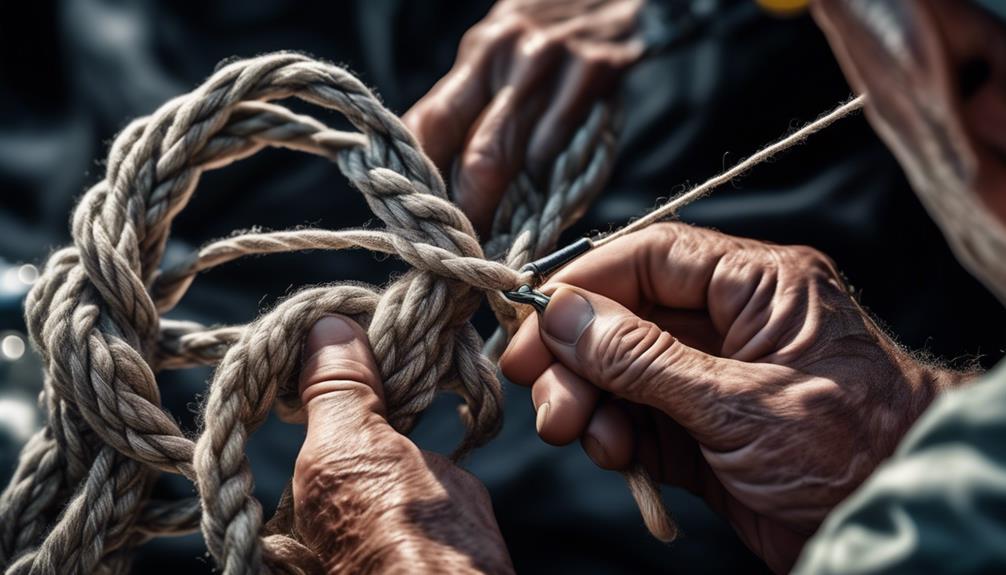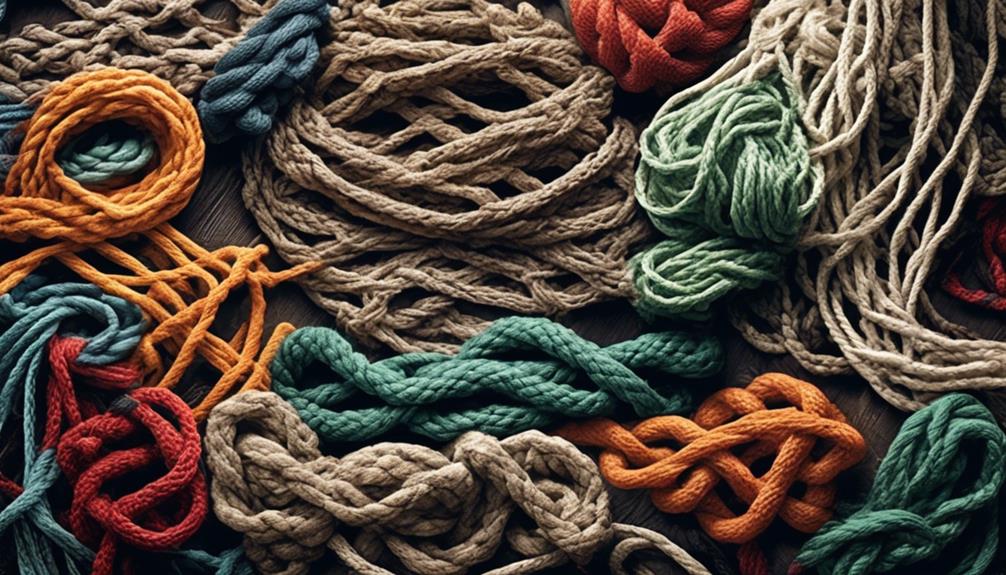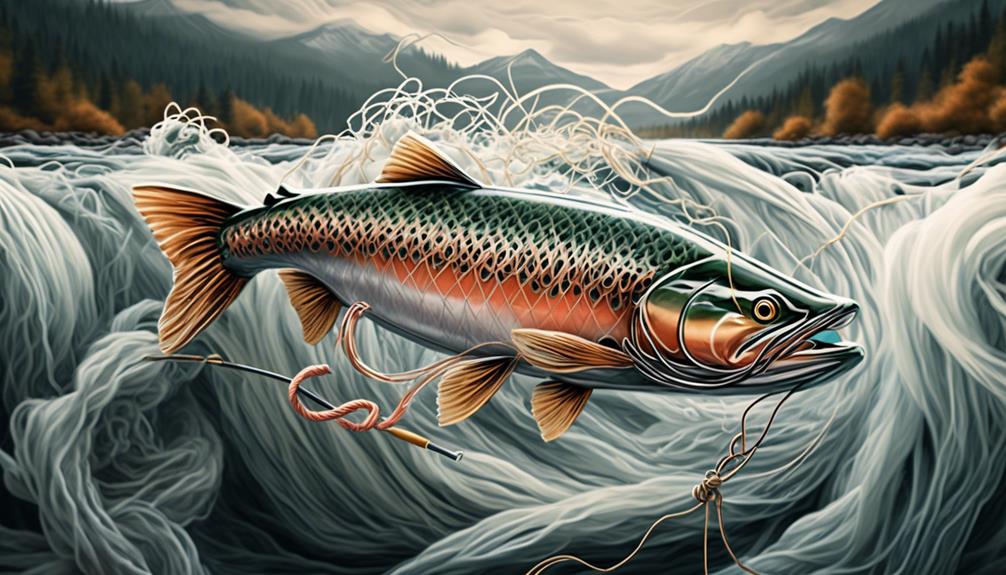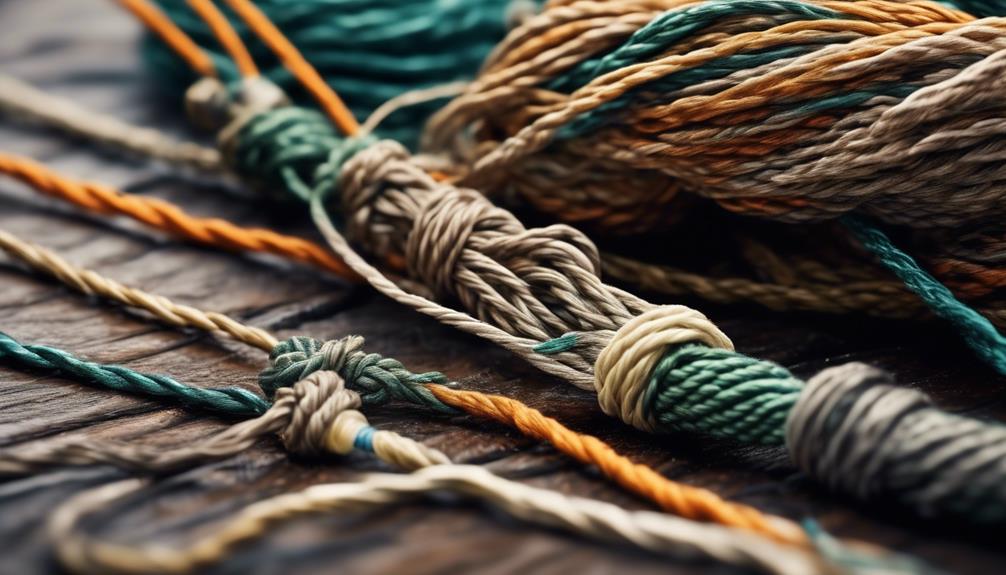Do you ever find yourself questioning the strength and security of your fishing knots? You want to ensure that your knots can withstand the pressure of reeling in a big catch, right?
Well, fret not, because we've got you covered with four essential tips for securing your fishing knots. These tips will not only enhance the strength and durability of your knots but also provide you with the confidence to tackle even the most challenging fishing situations.
So, let's get started on mastering the art of knot security for a successful fishing experience.
Importance of Knot Security
Ensuring the security of your fishing knots is crucial for preventing lost catches and ensuring a successful fishing experience. When it comes to knot security, two essential factors to consider are knot tension and material compatibility.
Proper tension in your fishing knots is vital for maintaining their strength and preventing them from slipping or breaking during the excitement of reeling in a big catch. By ensuring that your knots are tied with sufficient tension, you can minimize the risk of losing your prized fish due to a knot failure.
In addition to knot tension, material compatibility plays a significant role in the security of your fishing knots. Different fishing lines and hooks are made from various materials, each with its own unique properties. It's crucial to ensure that the knots you tie are compatible with the specific materials you're using.
For instance, certain knots may be better suited for monofilament lines, while others may work best with braided lines. Understanding the compatibility between your fishing line and the knots you use can significantly impact the overall strength and security of your knots.
Understanding Knot Strength
Understanding the strength of your fishing knots is essential for ensuring a successful and enjoyable fishing experience. When it comes to knot strength, there are a few key factors to consider that can significantly impact the reliability of your knots:
- Knot Material
- The type of fishing line and the material it's made of can greatly influence the strength of your knots. Different types of lines, such as monofilament, fluorocarbon, and braided lines, each have their own unique characteristics that affect how well they hold knots. Understanding the properties of your specific line material is crucial for selecting the most suitable knot and tying it correctly.
- Tension Control
- Proper tension control during the knot tying process is crucial for maximizing knot strength. Applying too much force when cinching down a knot can cause the line to weaken or even break. Conversely, insufficient tension may result in a loosely tied knot that's prone to slipping. Mastering the art of applying just the right amount of tension is essential for ensuring strong and reliable knots.
- Environmental Factors
- Environmental conditions, such as moisture, temperature, and exposure to UV radiation, can impact the overall strength of your knots over time. Understanding how these factors can affect the integrity of your knots will help you anticipate potential weaknesses and take appropriate measures to mitigate them.
Choosing the Right Knot
To select the appropriate fishing knot, consider the characteristics of your fishing line and the specific application for which the knot will be used. The type of fishing line you're using plays a crucial role in knot selection. For instance, monofilament lines work well with certain knots, while braided lines require different knot tying techniques due to their slick and smooth nature. The specific application, such as tying a hook or connecting two lines, also influences the choice of knot. Different knots have varying levels of complexity and strength, so it's important to match the knot to the fishing situation to ensure optimal performance.
When choosing the right knot, it's essential to consider knot tightness. A loose knot can reduce the breaking strength of the fishing line, making it more prone to failure when under pressure. On the other hand, a knot that's too tight may weaken the line, particularly with monofilament or fluorocarbon lines that are more susceptible to damage from friction and heat. Understanding the balance between a knot that's secure and one that doesn't overly stress the line is crucial for successful knot tying.
Proper Knot Tying Technique
For secure and reliable fishing knots, mastering the proper knot tying technique is essential. To ensure the strength and integrity of your fishing knots, it's important to pay attention to the finer details of tying the knot.
Here are some key tips to help you improve your knot tying technique:
- Use the Right Amount of Line: Ensure that you have a sufficient amount of line to work with when tying your fishing knots. Having too little line can make it challenging to form the knot properly, while having too much can lead to unnecessary tangles and twists.
- Make sure to leave a suitable tag end to work with when tying your knots, as this will make the process much easier and more manageable.
- Maintain Consistent Tension: When tying your fishing knots, it's crucial to maintain consistent tension throughout the process. Inconsistent tension can result in a weak and unreliable knot that's prone to slipping or breaking. Applying steady and even pressure as you tighten the knot will help to ensure that it holds securely and maintains its strength.
- Practice Good Technique: Take the time to learn and practice proper knot tying techniques. Whether you're mastering the clinch knot, palomar knot, or any other essential fishing knots, understanding and refining your technique is vital for knot security. Pay attention to the details of each knot tying process, such as the number of wraps or loops required, and the specific steps for securing the knot properly.
Testing Knot Integrity
After tying your fishing knot, routinely test its integrity by gently pulling on the line to ensure it holds securely. Testing the knot is crucial to avoid potential disappointment when a big catch is on the line. There are several testing methods you can employ to ensure your knot is secure.
The simplest method involves pulling the main line and the tag end in opposite directions. Applying gradual pressure will help you gauge the knot's strength without causing it to break or weaken. Another method is to jerk the line sharply to simulate the sudden force of a fish striking. If the knot holds under these abrupt movements, it's likely to withstand the tension of a strong catch.
Regularly testing your knots is essential because it allows you to identify potential weak spots or signs of knot failure before you cast your line. If a knot fails during testing, it's a clear indication that it's not reliable and needs to be retied. It's better to discover a weak knot while testing than to lose a prized catch due to knot failure during a crucial moment.
Enhancing Knot Durability
Enhance the durability of your fishing knots by reinforcing potential weak spots identified during routine testing, ensuring reliable performance when reeling in a big catch. To make sure your knots are as durable as possible, consider the following tips:
- Knot Lubrication: Apply a small amount of a suitable lubricant to the knot before tightening. This helps prevent friction during the cinching process, reducing the chance of the line weakening or breaking at the knot. Be cautious not to over-lubricate, as this can lead to the knot slipping during tightening.
- Knot Tightening: After forming the knot, ensure it's cinched down tightly and uniformly. Avoid rushing this step, as a poorly tightened knot is more prone to slippage and failure under pressure. Take your time to gradually tighten the knot, checking for any signs of uneven tension in the line.
- Selecting the Right Knot: Some knots are inherently more durable than others, especially when tying lines of different materials or diameters. Choose a knot that's suitable for the specific fishing situation and learn how to tie it correctly to maximize its strength and durability.
Maintenance for Longevity

To ensure the longevity of your fishing knots, regularly inspect and maintain them for optimal performance during your angling endeavors. One crucial aspect of maintenance is knot lubrication. Applying a small amount of specialized knot lubricant or even saliva to your knots before tightening them can significantly reduce friction and heat generated during the tightening process. This simple step can help prevent the weakening of the line and the knot, ultimately enhancing the overall durability of your fishing knots.
In addition to knot lubrication, preventing friction during the fishing knot tying process is essential for maintaining their longevity. When tying knots, make sure to pull the knot slowly and steadily to avoid friction, which can weaken the integrity of the knot. Also, ensure that the knot is cinched down smoothly without any sudden jerks or tugs that may cause unnecessary friction. By being mindful of these small yet crucial details, you can extend the lifespan of your fishing knots and minimize the risk of breakage during your fishing adventures.
Regularly inspecting your fishing knots for any signs of wear and tear is equally important for their longevity. Look for any fraying, damage, or weakening of the knots, and re-tie them if necessary. By incorporating these maintenance practices into your angling routine, you can enjoy more successful and stress-free fishing experiences with confidence in the reliability of your knots.
Additional Tips for Knot Security
Consider incorporating a double-loop knot for added security when attaching your hook or lure to the fishing line. This type of knot provides extra resistance against slippage and can be particularly useful when dealing with a slippery or smooth-surfaced hook.
In addition to utilizing a double-loop knot, there are several other measures you can take to enhance the security of your fishing knots. Here are some additional tips to consider:
- Knot Lubrication: Before tightening your knot, apply a small amount of saliva or specialized knot lubricant to the line. This simple step can help reduce friction and heat generated during the knot tightening process, ultimately leading to a more secure and reliable knot.
- Saliva: A readily available and effective option for lubricating your knots. Simply moisten the knot with saliva before cinching it down.
- Specialized Lubricants: There are various commercial products designed specifically for lubricating fishing knots. These lubricants are formulated to reduce friction and prevent damage to the line.
- Friction Reduction: To minimize friction and prevent premature wear on the line, consider using a smooth, consistent motion when tightening your knots. Avoid jerky or abrupt movements, as these can cause the line to weaken or fray, compromising the knot's security.
Frequently Asked Questions
What Are the Most Common Mistakes People Make When Tying Fishing Knots?
When tying fishing knots, the most common mistakes people make are rushing and not properly wetting the line before tightening, which can weaken the knot. To prevent these issues, take your time and ensure the line is moistened.
Proper technique involves carefully following the steps for each knot, and troubleshooting any issues that arise. By being patient and meticulous, you can avoid the most common mistakes when securing fishing knots.
Is There a Specific Type of Fishing Line That Is Best for Securing Knots?
When securing knots, the best fishing line depends on various factors like the type of fish and fishing conditions. Different lines have different knot securing techniques, so it's important to match the line to the knot you plan to use.
Some lines work better with certain types of knots, ensuring a secure hold. Understanding the best fishing line for your specific needs will help you achieve more successful knot securing.
How Can Environmental Factors, Such as Saltwater or Cold Temperatures, Affect the Security of Fishing Knots?
In saltwater or cold temperatures, environmental conditions can impact the security of fishing knots. The weather can weaken the knot strength, making it more prone to slipping or breaking.
It's crucial to consider these factors when tying fishing knots, as using the right technique and selecting the appropriate knot for the conditions can help ensure the security of your knots, preventing potential mishaps while out on the water.
Are There Any Special Tools or Accessories That Can Help Improve the Security of Fishing Knots?
You can improve the security of fishing knots by using special tools, accessories, knot tying techniques, or knot securing products. These items can help ensure that your knots stay strong and reliable, even in challenging environmental conditions.
Can You Provide Tips for Securing Knots When Using Different Types of Fishing Hooks or Lures?
When using different fishing techniques, it's crucial to secure knots properly. To achieve this, try advanced knot tying methods for various types of fishing hooks or lures. This can help prevent your knots from slipping or breaking, ensuring a successful fishing experience.
Conclusion
Now that you have learned these helpful tips for securing fishing knots, you can ensure that your knots are strong and reliable.
By understanding knot strength, choosing the right knot, using proper tying technique, testing knot integrity, and enhancing durability, you can enjoy a successful and worry-free fishing experience.
With regular maintenance and attention to detail, your knots will remain secure and dependable for all your fishing adventures.
Happy fishing!



